Input interpretation

NO_2 nitrogen dioxide + HI hydrogen iodide ⟶ H_2O water + I_2 iodine + N_2 nitrogen
Balanced equation
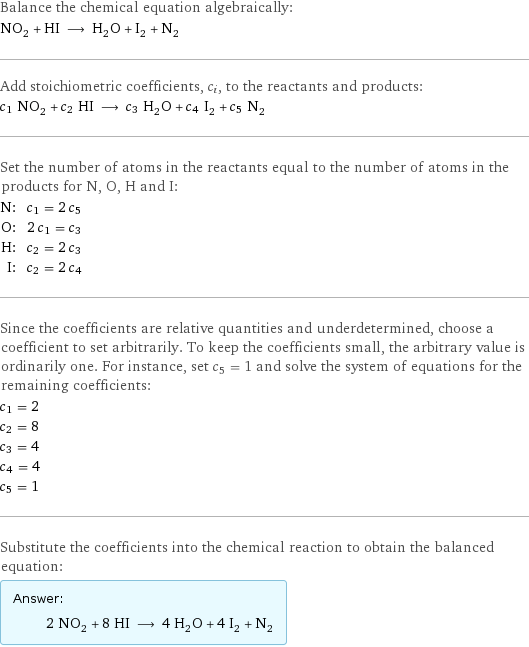
Balance the chemical equation algebraically: NO_2 + HI ⟶ H_2O + I_2 + N_2 Add stoichiometric coefficients, c_i, to the reactants and products: c_1 NO_2 + c_2 HI ⟶ c_3 H_2O + c_4 I_2 + c_5 N_2 Set the number of atoms in the reactants equal to the number of atoms in the products for N, O, H and I: N: | c_1 = 2 c_5 O: | 2 c_1 = c_3 H: | c_2 = 2 c_3 I: | c_2 = 2 c_4 Since the coefficients are relative quantities and underdetermined, choose a coefficient to set arbitrarily. To keep the coefficients small, the arbitrary value is ordinarily one. For instance, set c_5 = 1 and solve the system of equations for the remaining coefficients: c_1 = 2 c_2 = 8 c_3 = 4 c_4 = 4 c_5 = 1 Substitute the coefficients into the chemical reaction to obtain the balanced equation: Answer: | | 2 NO_2 + 8 HI ⟶ 4 H_2O + 4 I_2 + N_2
Structures

+ ⟶ + +
Names

nitrogen dioxide + hydrogen iodide ⟶ water + iodine + nitrogen
Reaction thermodynamics
Enthalpy
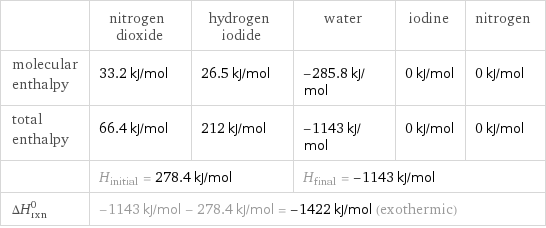
| nitrogen dioxide | hydrogen iodide | water | iodine | nitrogen molecular enthalpy | 33.2 kJ/mol | 26.5 kJ/mol | -285.8 kJ/mol | 0 kJ/mol | 0 kJ/mol total enthalpy | 66.4 kJ/mol | 212 kJ/mol | -1143 kJ/mol | 0 kJ/mol | 0 kJ/mol | H_initial = 278.4 kJ/mol | | H_final = -1143 kJ/mol | | ΔH_rxn^0 | -1143 kJ/mol - 278.4 kJ/mol = -1422 kJ/mol (exothermic) | | | |
Gibbs free energy
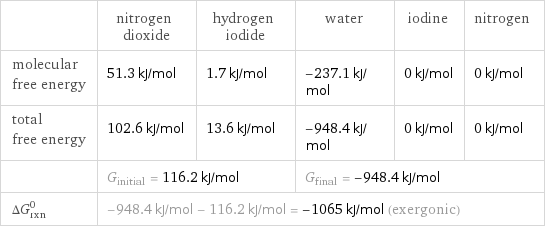
| nitrogen dioxide | hydrogen iodide | water | iodine | nitrogen molecular free energy | 51.3 kJ/mol | 1.7 kJ/mol | -237.1 kJ/mol | 0 kJ/mol | 0 kJ/mol total free energy | 102.6 kJ/mol | 13.6 kJ/mol | -948.4 kJ/mol | 0 kJ/mol | 0 kJ/mol | G_initial = 116.2 kJ/mol | | G_final = -948.4 kJ/mol | | ΔG_rxn^0 | -948.4 kJ/mol - 116.2 kJ/mol = -1065 kJ/mol (exergonic) | | | |
Equilibrium constant
![Construct the equilibrium constant, K, expression for: NO_2 + HI ⟶ H_2O + I_2 + N_2 Plan: • Balance the chemical equation. • Determine the stoichiometric numbers. • Assemble the activity expression for each chemical species. • Use the activity expressions to build the equilibrium constant expression. Write the balanced chemical equation: 2 NO_2 + 8 HI ⟶ 4 H_2O + 4 I_2 + N_2 Assign stoichiometric numbers, ν_i, using the stoichiometric coefficients, c_i, from the balanced chemical equation in the following manner: ν_i = -c_i for reactants and ν_i = c_i for products: chemical species | c_i | ν_i NO_2 | 2 | -2 HI | 8 | -8 H_2O | 4 | 4 I_2 | 4 | 4 N_2 | 1 | 1 Assemble the activity expressions accounting for the state of matter and ν_i: chemical species | c_i | ν_i | activity expression NO_2 | 2 | -2 | ([NO2])^(-2) HI | 8 | -8 | ([HI])^(-8) H_2O | 4 | 4 | ([H2O])^4 I_2 | 4 | 4 | ([I2])^4 N_2 | 1 | 1 | [N2] The equilibrium constant symbol in the concentration basis is: K_c Mulitply the activity expressions to arrive at the K_c expression: Answer: | | K_c = ([NO2])^(-2) ([HI])^(-8) ([H2O])^4 ([I2])^4 [N2] = (([H2O])^4 ([I2])^4 [N2])/(([NO2])^2 ([HI])^8)](../image_source/cf7a7975418203fdefe5bd4d47bba6cd.png)
Construct the equilibrium constant, K, expression for: NO_2 + HI ⟶ H_2O + I_2 + N_2 Plan: • Balance the chemical equation. • Determine the stoichiometric numbers. • Assemble the activity expression for each chemical species. • Use the activity expressions to build the equilibrium constant expression. Write the balanced chemical equation: 2 NO_2 + 8 HI ⟶ 4 H_2O + 4 I_2 + N_2 Assign stoichiometric numbers, ν_i, using the stoichiometric coefficients, c_i, from the balanced chemical equation in the following manner: ν_i = -c_i for reactants and ν_i = c_i for products: chemical species | c_i | ν_i NO_2 | 2 | -2 HI | 8 | -8 H_2O | 4 | 4 I_2 | 4 | 4 N_2 | 1 | 1 Assemble the activity expressions accounting for the state of matter and ν_i: chemical species | c_i | ν_i | activity expression NO_2 | 2 | -2 | ([NO2])^(-2) HI | 8 | -8 | ([HI])^(-8) H_2O | 4 | 4 | ([H2O])^4 I_2 | 4 | 4 | ([I2])^4 N_2 | 1 | 1 | [N2] The equilibrium constant symbol in the concentration basis is: K_c Mulitply the activity expressions to arrive at the K_c expression: Answer: | | K_c = ([NO2])^(-2) ([HI])^(-8) ([H2O])^4 ([I2])^4 [N2] = (([H2O])^4 ([I2])^4 [N2])/(([NO2])^2 ([HI])^8)
Rate of reaction
![Construct the rate of reaction expression for: NO_2 + HI ⟶ H_2O + I_2 + N_2 Plan: • Balance the chemical equation. • Determine the stoichiometric numbers. • Assemble the rate term for each chemical species. • Write the rate of reaction expression. Write the balanced chemical equation: 2 NO_2 + 8 HI ⟶ 4 H_2O + 4 I_2 + N_2 Assign stoichiometric numbers, ν_i, using the stoichiometric coefficients, c_i, from the balanced chemical equation in the following manner: ν_i = -c_i for reactants and ν_i = c_i for products: chemical species | c_i | ν_i NO_2 | 2 | -2 HI | 8 | -8 H_2O | 4 | 4 I_2 | 4 | 4 N_2 | 1 | 1 The rate term for each chemical species, B_i, is 1/ν_i(Δ[B_i])/(Δt) where [B_i] is the amount concentration and t is time: chemical species | c_i | ν_i | rate term NO_2 | 2 | -2 | -1/2 (Δ[NO2])/(Δt) HI | 8 | -8 | -1/8 (Δ[HI])/(Δt) H_2O | 4 | 4 | 1/4 (Δ[H2O])/(Δt) I_2 | 4 | 4 | 1/4 (Δ[I2])/(Δt) N_2 | 1 | 1 | (Δ[N2])/(Δt) (for infinitesimal rate of change, replace Δ with d) Set the rate terms equal to each other to arrive at the rate expression: Answer: | | rate = -1/2 (Δ[NO2])/(Δt) = -1/8 (Δ[HI])/(Δt) = 1/4 (Δ[H2O])/(Δt) = 1/4 (Δ[I2])/(Δt) = (Δ[N2])/(Δt) (assuming constant volume and no accumulation of intermediates or side products)](../image_source/cbfafb5d8c8dae42b4198a0c7587b167.png)
Construct the rate of reaction expression for: NO_2 + HI ⟶ H_2O + I_2 + N_2 Plan: • Balance the chemical equation. • Determine the stoichiometric numbers. • Assemble the rate term for each chemical species. • Write the rate of reaction expression. Write the balanced chemical equation: 2 NO_2 + 8 HI ⟶ 4 H_2O + 4 I_2 + N_2 Assign stoichiometric numbers, ν_i, using the stoichiometric coefficients, c_i, from the balanced chemical equation in the following manner: ν_i = -c_i for reactants and ν_i = c_i for products: chemical species | c_i | ν_i NO_2 | 2 | -2 HI | 8 | -8 H_2O | 4 | 4 I_2 | 4 | 4 N_2 | 1 | 1 The rate term for each chemical species, B_i, is 1/ν_i(Δ[B_i])/(Δt) where [B_i] is the amount concentration and t is time: chemical species | c_i | ν_i | rate term NO_2 | 2 | -2 | -1/2 (Δ[NO2])/(Δt) HI | 8 | -8 | -1/8 (Δ[HI])/(Δt) H_2O | 4 | 4 | 1/4 (Δ[H2O])/(Δt) I_2 | 4 | 4 | 1/4 (Δ[I2])/(Δt) N_2 | 1 | 1 | (Δ[N2])/(Δt) (for infinitesimal rate of change, replace Δ with d) Set the rate terms equal to each other to arrive at the rate expression: Answer: | | rate = -1/2 (Δ[NO2])/(Δt) = -1/8 (Δ[HI])/(Δt) = 1/4 (Δ[H2O])/(Δt) = 1/4 (Δ[I2])/(Δt) = (Δ[N2])/(Δt) (assuming constant volume and no accumulation of intermediates or side products)
Chemical names and formulas
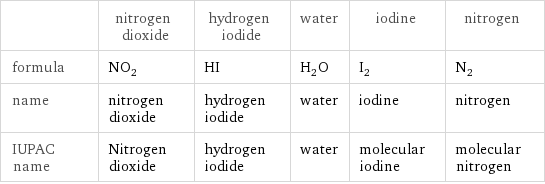
| nitrogen dioxide | hydrogen iodide | water | iodine | nitrogen formula | NO_2 | HI | H_2O | I_2 | N_2 name | nitrogen dioxide | hydrogen iodide | water | iodine | nitrogen IUPAC name | Nitrogen dioxide | hydrogen iodide | water | molecular iodine | molecular nitrogen
Substance properties
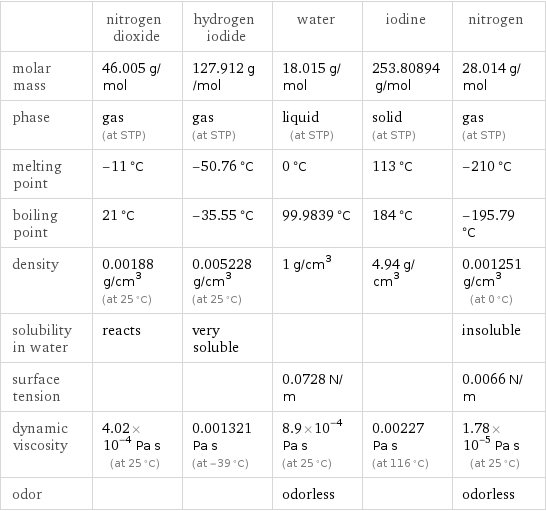
| nitrogen dioxide | hydrogen iodide | water | iodine | nitrogen molar mass | 46.005 g/mol | 127.912 g/mol | 18.015 g/mol | 253.80894 g/mol | 28.014 g/mol phase | gas (at STP) | gas (at STP) | liquid (at STP) | solid (at STP) | gas (at STP) melting point | -11 °C | -50.76 °C | 0 °C | 113 °C | -210 °C boiling point | 21 °C | -35.55 °C | 99.9839 °C | 184 °C | -195.79 °C density | 0.00188 g/cm^3 (at 25 °C) | 0.005228 g/cm^3 (at 25 °C) | 1 g/cm^3 | 4.94 g/cm^3 | 0.001251 g/cm^3 (at 0 °C) solubility in water | reacts | very soluble | | | insoluble surface tension | | | 0.0728 N/m | | 0.0066 N/m dynamic viscosity | 4.02×10^-4 Pa s (at 25 °C) | 0.001321 Pa s (at -39 °C) | 8.9×10^-4 Pa s (at 25 °C) | 0.00227 Pa s (at 116 °C) | 1.78×10^-5 Pa s (at 25 °C) odor | | | odorless | | odorless
Units
